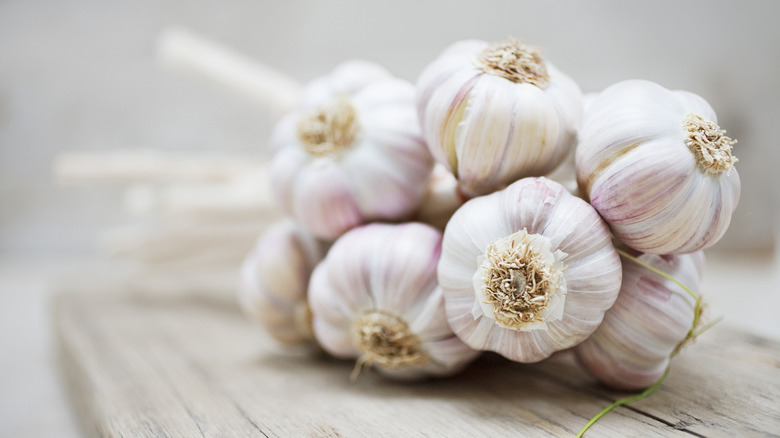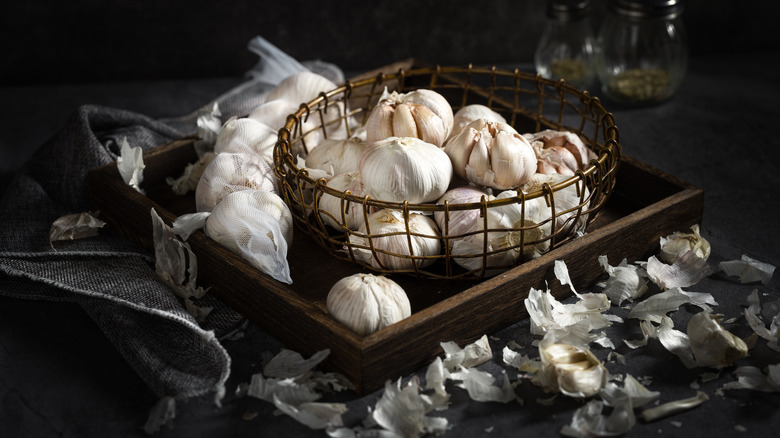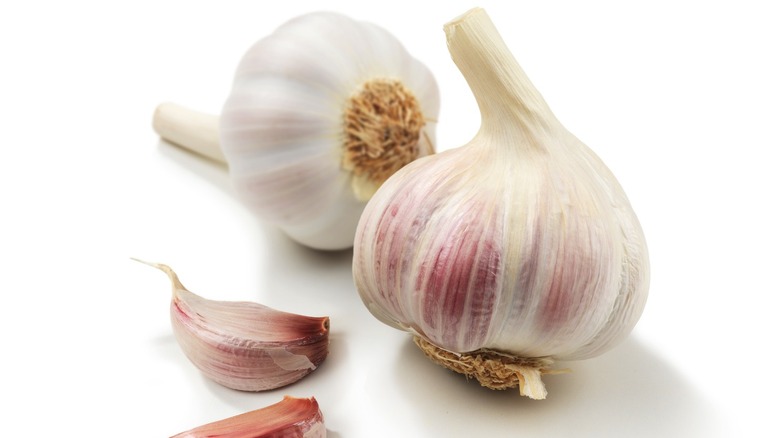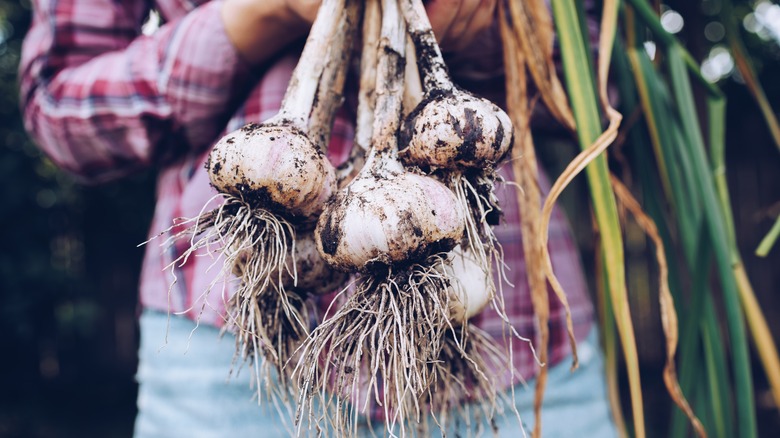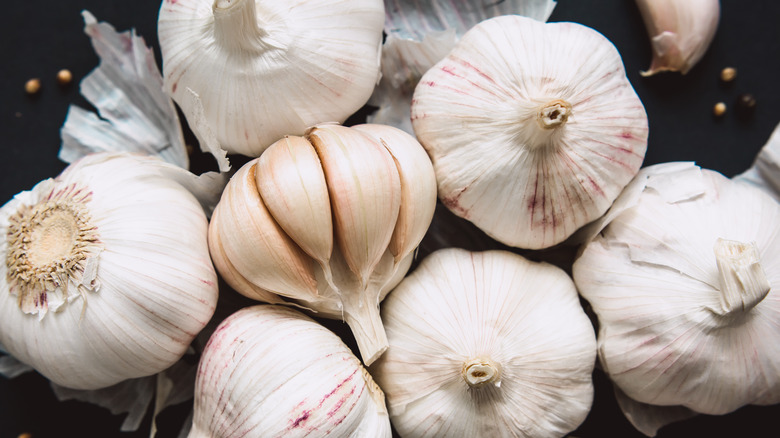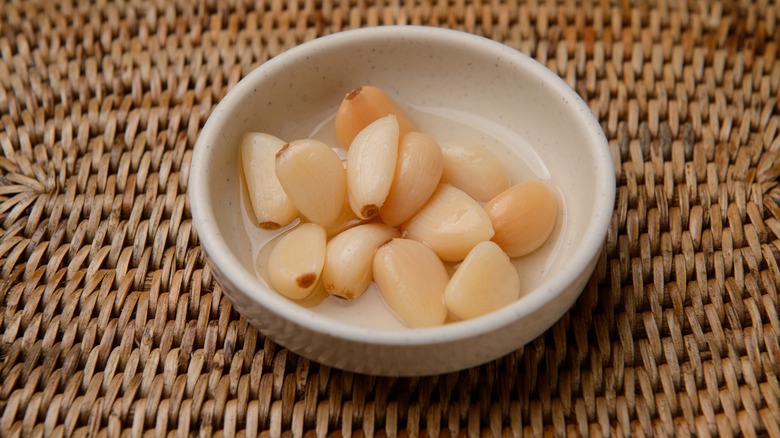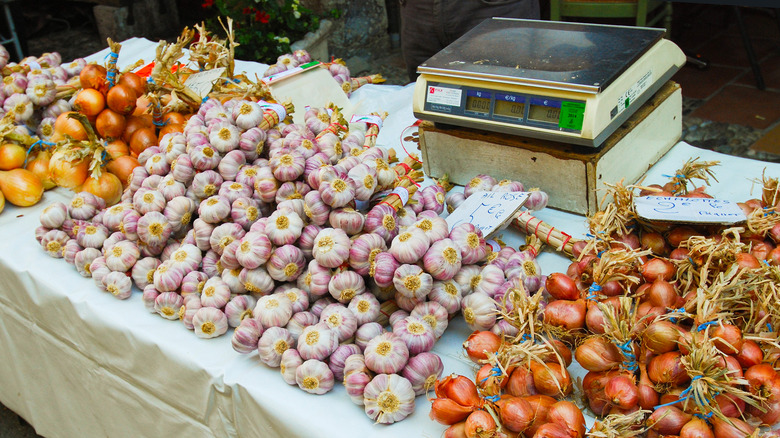The Subtle Differences Between American Garlic And Chinese Garlic
In the bulk of culinary styles of cultures worldwide, people all over are cooking with garlic. The slammin' little bulb boasts a myriad of medicinal benefits, basically defines "umami," and in the words of the late, great Anthony Bourdain himself, "Garlic is divine." Home and professional cooks turn to it for its signature pungent flavor and savory aroma. But, for as many chefs in the U.S. regularly use it, fewer are familiar with where their ingredient actually comes from.
Much of the garlic sold in the U.S. is imported from China. With hardneck vs. softneck, scapes, and spring garlic, it's easy to tell the major types of garlic apart with no more than a glance thanks to their different shapes and colors. However, it's not that way with American vs. Chinese garlic. Chinese garlic is generally more common and pungent, while American garlic is more physically inconsistent and has a milder flavor — and that's just the tip of the allium iceberg.
What is Chinese garlic?
Garlic is believed to be indigenous to Central Asia, where folks have been using it for over 5,000 years. Per the common lore, if the roots have been scraped off and the bottom of the bulb is smooth and concave, that's Chinese garlic. This is likely the type of garlic that many American cooks are most likely to find in grocery store produce aisles. If you spy intact roots, that's American garlic ... but only sometimes. A concave bottom isn't a universal differentiator between these two kinds of garlic, which are strikingly similar in both appearance and taste.
Thanks to its bold flavor and aromatic qualities, Chinese garlic is a popular choice among chefs for whipping up flavorful condiments, like the glossy, widely popular Chinese garlic sauce, which is often used in stir-fries or lo mein or served alongside dumplings, spring rolls, or marinated meats. Still, you can't definitively identify the difference between Chinese and American garlic flavors without taking a bite.
What is American garlic?
Further complicating the matter is that "to root" or "not to root" isn't a universally accurate indicator of American versus Chinese garlic. Some American growers and retailers simply prefer to remove the roots from their bulbs for aesthetic reasons. American garlic can often be identified by a certified organic sticker that lists its domestic source.
The two primary subtypes of American garlic are "California Early" garlic (which boasts an accessible mild flavor and is ready early in the harvest season, making it more widely available) and the more complex "Inchelium Red" garlic (which is richer with a more unique taste, lending dimensionality to dishes). Also, in addition to being a significant part of American agriculture, garlic made an appearance in early American folklore as a symbol of health and protection. Perhaps American garlic's highest praise is the fact that, due to its accessible, milder flavor, many fans enjoy munching on it raw.
Chinese garlic is grown in China, and American garlic is grown in the U.S.
Today, 75% of the global garlic supply is grown in China, especially the Shandong, Henan, and Jiangsu provinces. The regions provide ideal garlic-cultivating conditions with mild winters and moderate rainfall. The soil also makes a natural fit for garlic cultivation with thorough drainage and rich nutrient content. In 2022 alone, China exported a whopping 218,000 tons of garlic, primarily to the U.S., Japan, and South Korea. Asiatic garlic cultivars are among the first varieties of hardneck garlic to mature during the garlic growing season, which is also good for profitable production.
In the U.S., California and Oregon are the two largest garlic-growing states. Garlic production mostly remains in the domestic market, though it is also exported in smaller amounts. In 2022, American growers produced an estimated 400 million pounds of garlic in total and exported 264,255 pounds to Canada, Mexico, and Japan, according to Garlics.com. Wherever they come from, foodies can't seem to get enough of that inimitable roasted garlicky flavor.
Their physical appearance seems identical, until you look a little closer
The most immediately obvious indicator of Chinese garlic bulbs is that they are round with a flat bottom and wrapped in an outer layer of crisp white paper skin. Chinese garlic bulbs are fairly consistent in physical appearance, clocking in around a medium size with 10-12 distinctly separated medium-to-large cloves. American garlic, on the other hand, ranges from small to large bulb sizes, and the shape can be round or elongated. Each bulb yields 4-6 cloves organized around a central stalk, and the outer skin can be white, tan, or purple.
The reason behind removing the roots from the bulb is twofold. U.S. regulations require that imported produce be free from any potentially contaminated soil for phytosanitary reasons. According to USDA regulations, garlic (and garlic relatives like leeks and onions) "are admissible from countries outside the Western Hemisphere only if the above-ground portion of the plant is removed." Plus, removing the roots and any lingering dirt also reduces the overall weight of the garlic bulb, thereby lowering shipping costs.
The biggest difference is in the taste
Foodies who describe themselves as self-professed "garlic lovers" might be more inclined to favor the Chinese variety. Chinese garlic cultivars have a bold, strong, intense, and slightly spicy flavor and potent aroma. Due to this punchy profile, the ingredient is commonly used in stir-fries, sauces, and soups, or more traditional Chinese dishes like garlic chicken lo mein, spicy garlic Szechuan noodles, or aromatic garlic-ginger beef stew.
American garlic is comparably much milder, making it a popular choice for pasta sauces, marinades, and oven-roasted garlic bulbs with olive oil. It's a more versatile ingredient than fiery Chinese garlic for different uses in the kitchen. The two types of garlic come with unique health benefits as well. Chinese garlic is rich in manganese, selenium, and vitamins C and B6, whereas American garlic is a good source of calcium and potassium; it also contains vitamins C and B6 but in smaller amounts.
Chinese garlic is more widely available, but American garlic can still be found with some scouring
Chinese garlic tends to be more easily accessible and lower cost than American garlic due to lower production prices. This wide availability and lower price are maintained by the fact that many domestic growers opt to cultivate other, more profitable crops since garlic draws a low profit margin, which perpetuates the need to import Chinese garlic to satisfy consumer demands.
At the end of the day, one type of garlic is not inherently more desirable than the other; it's all a matter of individual preference. But, if you do prefer one type over the other, keep an eye out for a certified organic label the next time you hit the grocery store. The search for American garlic can also be a great excuse to patronize your local farmers market or CSA farm. For particularly avid garlic lovers, you could even snag some seeds and grow them yourself, which would also ensure pesticide-free cultivation.
